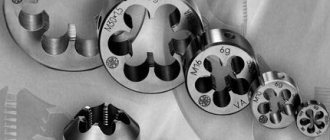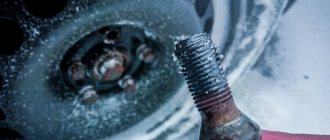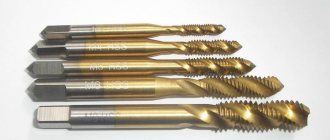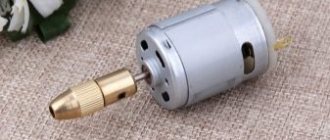What is a die?
A die is a tool for creating threads on the outer surface of cylindrical workpieces. Uniform twisted grooves appear on the machined side, onto which the connecting part is screwed. Smooth threads are obtained thanks to the complex arrangement of edges located on the inside of the tool. As the tool rotates, the sharp edges create uniform turns.
The design of the die is cylindrical in shape with precise placement of cutters on the inside. The diameter varies depending on the size of the workpieces being processed. The equipment has holes that are needed to secure the knob. With its help, force is transmitted to the equipment.
External thread cutting
An integral part of any threaded connection is the externally threaded component . It is he who screws into the hole with internal threads. Rotating bodies, that is, shafts, are equipped with an external threaded surface. This type of thread is typical for bolts, studs, lead screws, all kinds of couplings and adapters .
A special tool is used to cut external threads:
- Die
- Die holder
As is clear, the die is inserted into the die holder. The die fixed in the holder is placed on the tip of the chamfered shaft. Next, the die is pressed down and screwed onto the shaft.
The height of the dies depends on the diameter of the thread being cut. On average, a die has 8 helical grooves. If we consider dies for cutting metric threads, the industry offers dies from M3-M6 to M52. In addition to dies for cutting traditional metric threads, there are dies for pipe (inch) threads, which can be either cylindrical or conical.
A type of dies is lerka. The key difference between lerks and dies is the design. The lerka is presented as a one-piece product . The die can have a split or sliding design .
- Split dies have a cut on one side, which makes the threaded product springy . Split-type dies are typically used to renew clogged or stripped threaded surfaces .
Of course, the split die can also be used for direct thread cutting. But due to the spring design, the accuracy of the threaded surface will be far from ideal. As a rule, the first, so-called “roughing” pass is made with a split die.
- Sliding dies have a collapsible design. If in split dies the cut is made only on one side of the product, then in sliding analogues the die is cut into 2 equal parts.
Sliding type dies usually have a prismatic shape . To work with such dies, you should use a die with a clamping mechanism.
There are 6 standard die sizes.
Sliding dies are characterized by increased durability. Thanks to the collapsible design, the cutting edges can “play” under critical loads. This avoids the appearance of chips and cracks on the threaded grooves.
Of course, the collapsible design of the dies affects the accuracy of thread cutting. Usually, with the help of a collapsible prismatic die, it is possible to achieve 6-7 quality accuracy , while non-separable analogues provide the possibility of obtaining threads of 8-9 quality .
- Solid lerks are cast one-piece dies. The main advantage of the lehr is the ability to cut threads with a high degree of accuracy . The good quality of the resulting thread is due to the non-demountable rigid structure.
Regarding weak points, the lehrs have them. The high rigidity of the structure makes such dies susceptible to chips and cracks. The cut edges in lehrs often become chipped. Leathers are significantly inferior in durability to split and sliding analogues. When using a lehr, it is recommended to use plenty of lubricant . Cooling won't hurt either.
Classification
In construction stores you can see different types of tools. Equipment is classified according to the following criteria:
- hull design;
- a method for creating coils on the surface of a workpiece;
- equipment form.
If we talk about classification by form, we can distinguish the following types of instruments:
- round dies;
- tubular equipment;
- square dies;
- equipment in the shape of a polyhedron.
Speaking about the design of the tool, we can distinguish the following groups:
- One-piece equipment. The most popular option. It is a round cast form whose body cannot be disassembled. It has several holes for securing the knob. This type of tool gained popularity due to its ease of use, reliability, and durability. The sharpening of the cutters lasts for a long time.
- Cutting tools. Special devices that have certain design features. Thanks to this, the process of creating threads is simplified.
- Sliding structures. They are modern devices that can be expanded to the required diameter. These are expensive models.
Another classification concerns the purpose of the equipment. There are 3 groups:
- production of round threads;
- creating a cylindrical threaded connection;
- production of conical threads.
Devices are made in factories in compliance with a number of standards specified in government documents GOSTs.
Types of dies for thread cutting
Internal thread cutting
To cut internal threads, the master will need a tap and a driver. The tap consists of 3 main parts:
- cutting part
- Calibrating part
- Shank
There are 3-4 grooves along the screw thread of the tap, which are used to remove chips. The tap can have several types of heads:
- Elongated pointed
- Flat
Taps with an elongated pointed head are used for cutting threads in through holes . In this case, the pointed head helps center the cutting part of the tap when creating the first turns.
Flattened taps are used to make threads in blind holes . With such taps it is a little more difficult to cut the first turns of the thread.
The tail part of the tap is inserted into the driver. The head of the tap is placed in the hole and the tap is screwed in with a rotating motion, thus cutting the thread.
Tap kits are usually available for internal threading. If the thread is created in ordinary carbon steel, then for screw cutting it is recommended to use 2 taps, roughing and finishing .
The first pass is made with a roughing tap. The essence of a rough tap is to create a thread blank. In this case, when passing through a finishing tap, you can achieve the cleanest and most accurate helical groove . When working with a finishing tap, there is no longer any need to center the tool and make excessive efforts to cut metal.
If the internal thread is created in stainless steel or hard alloy, then it is best to use a set of 3 taps: rough, semi-finish, finishing. Triple passage with different taps allows you to achieve a high quality helical groove .
When making internal threads in titanium alloys, it is recommended to use a set of 5 taps!
What else do you need to know about the types of carvings?
Manual or machine internal thread cutting
As a rule, only metric threads are cut by hand. In this case, the diameter of the helical groove is usually no more than 20 (mm). If you need to create a larger thread, the craftsman will need the help of equipment. The same applies to pipe (inch) type threads.
For machine thread cutting the following are usually used:
- Lathe
- Drilling machine
- Threading machine
It is very easy to distinguish between hand and machine cutting taps. In manual type taps, the tail part has a square slot , which allows you to fix the tool in the driver. Machine taps have a shank for a collet clamp or a self-centering chuck. In some cases, the tap shank is created under a Morse taper.
A separate category of tools for machine cutting internal threads uses the so-called rolling taps . Such taps do not have grooves for chip exit. In this case, the thread is created without the formation of chips.
How to cut a thread with a die.
Rules for cutting threads using dies
Cutting threads with a die manually requires compliance with certain rules. Knowing the principles of working with the tool, you can create a high-quality, durable connection. In order to work with the device for creating a threaded connection, you need to use a die holder. Work rules:
- Determine the exact diameter of the pipe, select equipment according to the markings indicated on its surface.
- Prepare the workpiece. Remove the chamfer using a file. The chamfer angle should be no more than 45 degrees. A larger angle will make the connection poor quality.
- To make the cutting edges last longer, you need to use lubricant during operation. It could be motor oil. They lubricate cutting parts and workpieces.
- The die holder must be turned clockwise two turns, then make 1 turn in the opposite direction. When the cutting edges move backward, the resulting chips come out and do not become clogged in the finished turns. It is important to hold the tool with the crank strictly vertically so that the threads are straight.
- After creating the first 3-4 turns, you need to reduce the stroke of the die in the opposite direction. It will be enough to make two turns clockwise and half a turn counterclockwise. You cannot continue working if the equipment is overheated; you need to take breaks.
When the required number of turns has been made, the quality of the finished connection needs to be checked.
To do this, you need to take a nut of the selected diameter and try to screw it onto the pipe. The first times the nut will be screwed on slowly, with difficulty. Gradually these problems will disappear. Uneven threads can cause damage to the connection during operation. Dies are used to create external threads on cylindrical parts. It is important to choose the right diameter and know the rules for working with equipment. The inside of the round parts is processed using swords. The equipment is suitable for both manual work and industrial equipment.
How to make a carving
The threaded connection includes 2 components:
- Internal thread
- External thread
A separate tool is used to produce each type of threaded surface. Internal threads are created using taps . The tap is used in conjunction with the driver. The external thread is created with a die , which in turn is installed in the die holder.
How to cut a thread with a tap.
What is a tap? Design types and how to use them
The difference between die taps and nut taps is that the former has a large intake cone and its purpose is to cut threads in one pass in the dies. Well, the last type, the master type, is usually used to clean the threads in dies after it has been cut with a die tap, and for a similar process with threads in working dies. The grooves of the master taps are made with a spiral to the right.
Fluteless swords differ from conventional machine tools, as the name implies, by the complete absence of longitudinal grooves, and the receiving cone on them is much shorter. At the tip of the threaded part there is a pair of small grooves, with the axis inclined towards the center of the tool. Grooveless taps are an order of magnitude stronger than others, rarely break, and do not produce defects. Since they have a longer thread, they can be re-sharpened many times, so they have a longer service life.
The main advantage of fluteless taps is undoubtedly their high productivity during thread cutting, especially considering their use in through and blind holes, and not just in one. Combined taps are represented by two parts and a neck separating them, and they are divided into grooveless, two-stage and drill-tapping taps. Using them saves a lot of time, because here you need to use only one tool, and not a whole set.
Terms of use
To create a screw on a pipe, you will need a set of appropriate dies, knobs and a special clamp. For thread cutting, the most suitable set of dies is selected depending on the diameter of the pipe and the required pitch of the turns. Some parameters can be determined by visual inspection of the surface, but there must also be appropriate markings on the surface of the housing. Do not forget that the screw being created can be left or right.
The entire process of creating a screw on a pipe can be divided into several main stages:
Work should begin with preparing the pipe. The metal surface must not have rust or serious defects. Cleaning can be done fairly quickly using special devices. A chamfer is removed from the end surface. This work can be done using a file. As with a tap, the surface should be lubricated with oil or some other similar substance. Without a lubricant, high loads may occur during operation, which will lead to deformation of the cutting edge. The die is fixed in a special die holder
Attention is paid to how strong the fastening is, since a high load can be transferred to the main part of the tool. During operation, one hand rotates the tool, the other - presses it. For a tool to cut into metal, there must be a significant impact on it. It is recommended to make two turns in the thread direction and one turn in the opposite direction.
This ensures that the resulting chips are removed from the cutting zone, which facilitates the movement of the tool.
Higher quality threads can only be obtained by using a split die. This is due to the fact that the design has a locking ring with which the diameter is adjusted.
When carrying out work, it should be taken into account that there are several types of screw connections:
- Triangular.
- Trapezoidal.
- Rectangular.
- Persistent.
The thrust type of connection is characterized by the fact that constant one-sided pressure is exerted on the elements being connected. That is why the coils must have high strength. The rectangular type of connection is characterized by the fact that it is used to combine moving structural elements.
In conclusion, we note that there are quite a large number of sets of dies on sale. If thread cutting work is carried out frequently, then you should purchase kits from well-known manufacturers who use high-quality steel when creating tools.
How to cut threads on a pipe - 2 effective options for solving the problem
Having your own home in these times of crisis is a great blessing
And it doesn’t matter whether we are talking about a city apartment or a private house. In any case, a person feels solid ground under his feet amid this sea of instability
If only you had your own home, and all the work on its improvement can be done with your own hands. Of course, for this you need to have a great desire and good tools. As for skills, they can be acquired in the process of performing various activities. Naturally, one cannot do without a theoretical study of the basics of the production of certain works. Within the framework of this article, we propose to examine the topic of how to cut threads on a pipe. Naturally, we are interested in the most popular ways to perform this operation in a home workshop.
Existing threading options
Pipe threads are divided into five types, but the most popular options are conical and cylindrical. Household members often encounter such types of pipe threads. There are two methods for threading a water pipe:
- Automatic, which involves cutting threads on water supply pipes using special machines and power tools.
- Manual. For this, special hand tools are used.
If, as part of his job, a person needs to cut threads on a large number of pipes, then it is appropriate to purchase a special power tool, which will facilitate manual labor.
When the need to obtain a threaded connection is an isolated case, then manual technology is suitable for such purposes. On water pipelines, as well as pipes of heating systems, thread cutting is performed using a die.
The die is a steel disk, and its inner diameter has axial holes in different numbers, which depends on the size of the product. The edges of these holes form cutters, with the help of which thread cutting is performed. To ensure the reliability of such a tool, it is made of alloy steel or hard alloys.
Dies can have different shapes (round, square, hexagonal or prismatic), but most often disc options are used. Disc dies are intended for making threaded connections on water pipes. To make it convenient to work with the die, they are equipped with additional knobs, as well as clamps in the form of screws. Dies are also solid, split and sliding.
Solid dies for threading pipes have one significant drawback - rapid wear of the cutters. This is due to the rigidity of the product’s own design. Split or spring-loaded dies have a less rigid design, which significantly increases the service life of the product. Due to the spring-loaded mechanism, such a tool for cutting threads on pipes allows you to vary the diameter of the resulting threaded connections in the range from 0.1 to 0.3 mm. A device of this type is highly resistant to cutter wear, but is not capable of providing high accuracy.
Sliding dies are 2 working parts intended for installation in a mounting module. A die with a special fastening module forms a tool called a pipe clamp. The die is fixed in the die using a cracker and an adjusting screw. It is with the help of the adjusting screw that the thread diameter is adjusted.










